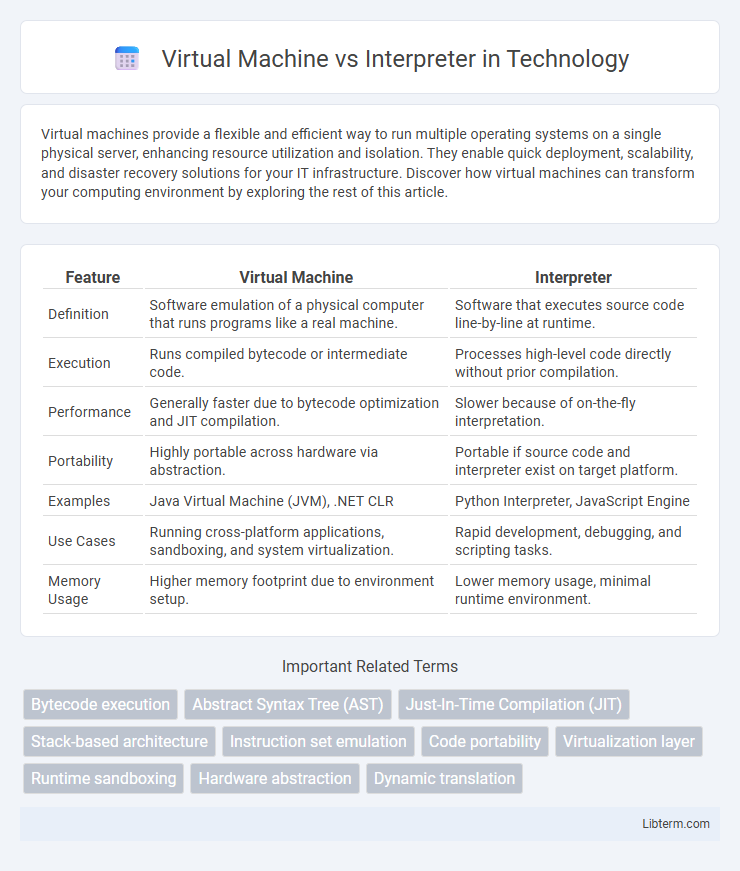Virtual machines provide a flexible and efficient way to run multiple operating systems on a single physical server, enhancing resource utilization and isolation. They enable quick deployment, scalability, and disaster recovery solutions for your IT infrastructure. Discover how virtual machines can transform your computing environment by exploring the rest of this article.
Table of Comparison
| Feature | Virtual Machine | Interpreter |
|---|---|---|
| Definition | Software emulation of a physical computer that runs programs like a real machine. | Software that executes source code line-by-line at runtime. |
| Execution | Runs compiled bytecode or intermediate code. | Processes high-level code directly without prior compilation. |
| Performance | Generally faster due to bytecode optimization and JIT compilation. | Slower because of on-the-fly interpretation. |
| Portability | Highly portable across hardware via abstraction. | Portable if source code and interpreter exist on target platform. |
| Examples | Java Virtual Machine (JVM), .NET CLR | Python Interpreter, JavaScript Engine |
| Use Cases | Running cross-platform applications, sandboxing, and system virtualization. | Rapid development, debugging, and scripting tasks. |
| Memory Usage | Higher memory footprint due to environment setup. | Lower memory usage, minimal runtime environment. |
Introduction to Virtual Machines and Interpreters
Virtual machines execute bytecode or intermediate representations, allowing programs to run across diverse hardware without modification, enhancing portability and security. Interpreters directly process high-level source code line-by-line, enabling immediate execution but often at the cost of slower performance compared to virtual machines. Both systems facilitate dynamic program execution, with virtual machines offering a versatile abstraction layer and interpreters focusing on straightforward code interpretation.
Core Functionality: How Virtual Machines Work
Virtual machines execute programs by translating high-level instructions into intermediate bytecode, which the VM processes through a stack-based or register-based architecture, enabling platform independence and resource management. They provide an abstraction layer that isolates software from underlying hardware, allowing consistent execution environments across different systems. Virtual machines also manage memory allocation, garbage collection, and system calls, enhancing security and efficiency compared to interpreters that directly execute source code line-by-line.
Core Functionality: How Interpreters Operate
Interpreters execute source code by translating and running instructions line-by-line in real-time, enabling immediate feedback and easier debugging compared to virtual machines. They parse high-level programming language statements directly into machine actions without creating an intermediate representation like bytecode. This method sacrifices execution speed for flexibility and simplicity, making interpreters ideal for dynamic scripting languages.
Key Differences Between Virtual Machines and Interpreters
Virtual machines execute compiled bytecode on a simulated hardware layer, providing platform independence and improved performance through just-in-time compilation. Interpreters directly execute source code line-by-line, offering flexibility and ease of debugging but typically lower execution speed. Virtual machines abstract hardware differences and manage resources, whereas interpreters focus on immediate code execution without prior translation.
Performance Comparison: Speed and Efficiency
Virtual machines execute code by translating instructions into platform-independent bytecode, which often results in faster execution compared to interpreters that process source code line-by-line at runtime, introducing higher overhead. The just-in-time (JIT) compilation used in many virtual machines improves speed by converting bytecode into native machine code dynamically, enhancing overall efficiency without sacrificing portability. Interpreters generally provide slower performance due to continuous parsing and interpretation, making virtual machines a preferred choice for applications requiring optimized speed and resource management.
Portability and Platform Independence
Virtual machines provide a high level of portability by executing platform-independent bytecode, allowing the same program to run on multiple hardware architectures without modification. Interpreters translate source code line-by-line on the host machine, which can limit portability due to dependencies on the interpreter's implementation and the underlying operating system. Platform independence is more reliably achieved through virtual machines because they abstract the underlying hardware and OS, enabling consistent execution across diverse environments.
Security Implications of Virtual Machines vs Interpreters
Virtual machines provide stronger security isolation by executing code within a controlled environment with dedicated memory and process boundaries, reducing the risk of direct system access or malicious interference. Interpreters, while flexible and dynamic, often run code in a less isolated context, increasing vulnerability to injection attacks and unauthorized system calls. Sandboxing techniques used in virtual machines further enhance protection against malware and unauthorized code execution compared to typical interpreter environments.
Use Cases and Real-World Applications
Virtual machines are ideal for running compiled bytecode in environments requiring platform independence, such as Java applications on enterprise servers and Android apps on mobile devices. Interpreters excel in development and debugging stages for dynamic languages like Python and JavaScript, enabling immediate code execution without prior compilation. Both technologies serve critical roles: virtual machines provide consistent runtime environments across diverse hardware, while interpreters offer flexibility and speed in iterative development.
Pros and Cons: Virtual Machine vs Interpreter
Virtual machines offer platform independence and efficient execution by translating code into an intermediate bytecode, enabling near-native performance and enhanced security through sandboxing. Interpreters facilitate immediate code execution without prior compilation, making them ideal for rapid development and debugging but often at the cost of slower runtime performance. While virtual machines provide better optimization and scalability for complex applications, interpreters excel in flexibility and simplicity for small-scale or dynamic scripting tasks.
Conclusion: Choosing the Right Approach
Selecting between a virtual machine and an interpreter depends on factors such as execution speed, platform compatibility, and resource availability. Virtual machines provide faster execution and better optimization for complex applications, while interpreters offer simplicity and ease of debugging for smaller scripts. Developers should prioritize performance needs and deployment environments to determine the most suitable approach for their programming projects.
Virtual Machine Infographic

 libterm.com
libterm.com